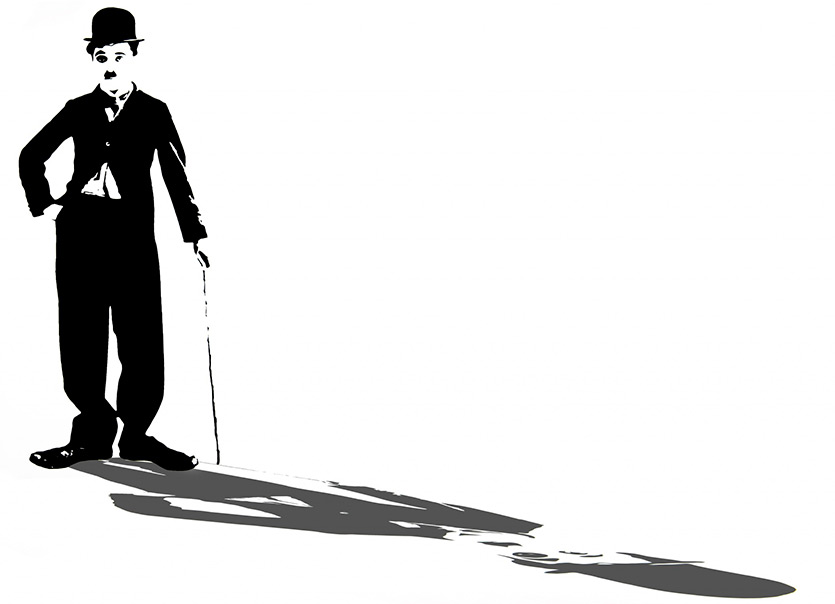Think
The mirror of the twentieth century reflected a clown
Slaps, kicks and slaps. By means of this, a charismatic and somewhat melancholic clown
has been able to convey the hopes and fears of millions of people all over the world.
Between robust optimism and deep sadness is Charlot: that is his life and his comedy.

Mute Charlot
Charlot was, no more and no less, the world's first great film star. He became a universal figure, revered and admired. The time he lived in, with its many contradictions - we all know that the first half of the 20th century was far from tranquil - was reflected in a complex and lively personality.
Chaplin began by transferring to the cinema the vaudeville from which he had learned the techniques and comedy as a child. The starting point in 1914 was Slapstick, a comedy in which the exaggeration of physical violence has no real consequences: everything you know about pies in the face and kicks in the arse and much more.
If you're not sure how it happened or you're just curious, you can watch these two VERY funny and short videos, with Harold Lloyd and Buster Keaton (Chaplin's colleagues and great figures in the world of Slapstick). You can watch them forever without getting tired of them:
For Heaven's Sake (1926), by Sam Taylor (producer Harold Lloyd), starring Harold Lloyd.
This excerpt is a good comic micro-story whose main message could be:
"Run and fight for what you want". Harold Lloyd, as seen at grade in the video,
was one of Chaplin's impersonators, from whom he eventually incorporated certain character traits of his own.
character traits of his own character.
Sherlock Jr. (1924), directed by Buster Keaton, starring Buster Keaton.
The slapstick violence here only appears once, but it's worth it.
What is most amusing is the expressionless face of the protagonist.
And what is most admirable is his ability to do all these stunts himself
all these stunts by himself without any support or safety.
These two are good examples of the Slapstick movement, albeit a little late. Here are the Wiki links in case you are interested in reading more about either of these two: Buster Keaton and Harold Lloyd.
Returning to Charlie Chaplin, thanks to Slapstick (in which he was undoubtedly king), the actor achieved immense popularity very early on. Already in 1915, little more than a year after starting his film degree program , Chaplinitis had awakened: an overflowing fame of the character, reflected in a merchandising never seen before in history.
"In New York, toys and figurines of my character were sold in every store and shop.
The chorus girls of the Ziegfield Follies did Chaplin-like numbers, altering their beauty with moustaches, mushroom hats, huge shoes and baggy trousers,
mushroom hats, huge shoes and baggy trousers, singing a song called "The Ziegfield Follies".
Those Charlie Chaplin feet! We were inundated with all class of business propositions
related to books, clothes, fabrics, toys, cigarettes and toothpaste. In addition, piles
and piles of increasing correspondence from admirers created a real problem".
(Mi autobiografía, Madrid, 1989 [1964], pp. 188-9).
Those Charlie Chaplin feet!
It was not only in the Anglo-Saxon world. The name Charlot was coined in France. It was used to overcome the barrier of language (basically any language ) thanks to the great asset of silent films:
Gesturality as the foundation of the character was the core topic: the absence of the spoken word facilitated understanding in cinemas all over the world without any need for mediation by translation or censorship. Cinema, especially comic cinema, was a universal art, as it possessed the universality of body language. Charlot was its first ever superstar.
His expressiveness made feelings of joy and sadness, of self-improvement staff and optimism, accessible to people all over the world. His viewers identified with a fictitious but profoundly human character in a time of upheaval and dehumanisation. The First World War, the great Russian revolution, the numerous crises and other not very pretty events were the slapstick within life itself.
Chaplin's popularity could be seen as soon as he began to travel outside the USA. The receptions on his arrival in London (1921), Venice and Berlin (1931), Paris (1932), Bali (1932)... are recorded in newsreels showing crowds cheering the star of the screen, the Charlot with whom the underprivileged identified so much. Here is a good example:
Chaplin in Venice - look how nice he looks!
Sound Charlot
The arrival of the talkies in 1927 affected Chaplin very directly. However, director maintained his desire to continue making silent films. In the end, however, he had to give in, putting an end to the character of the tramp with the moustache. Charlie was a tough man, so he did not let his character go unchallenged:
"I detest talkies. They have come to spoil the oldest art in the world, the art of pantomime;
They annihilate the great beauty of silence. They demolish the present edifice of the cinema, they destroy the
current which draws the actors to popularity, and the friends of the cinema to the attraction of beauty.
attraction of beauty. Plastic beauty makes the most important thing last on the screen.
Cinema is a pictorial art".
(My autobiography, Madrid, 1989 [1964], p. 359).
Is cinema really as pictorial as Chaplin thinks it is? Many of us like good dialogue, some film phrases even enter the collective imagination: "Hasta la vista, baby" or "we'll always have Paris" or the famous "I'll be back" from Terminator.
Charlot certainly couldn't stop the progress, neither did fashion defeat sound films. However, he has surpassed all those who made sound films in his time. To be sure of that, one only has to see what director does with the few words (or the no-words) that appear in his latest films:
The nonsense song by Charlot in the film Modern times.
This is the first time Chaplin has ever made sounds. A pity they don't make any sense. Everyone longed to hear the voice of the super-hyper-great-universal-star. And instead of the words, they heard a beautiful nonsense never seen before on the screens and very coherent with what his vagabond character was. Here are the lyrics (you can pass them on, they make no sense in any case):
|
Se bella giu satore Je notre so cafore Je notre si cavore (Je la tu la ti la ti la twah La spinash or la bouchon Cigaretto Portabello Si rakish spaghaletto Ti la tu la la ti la ti la twah |
Ms. pilasina Voulez-vous le taximeter? Le zionta su la seata Tu la tu la la la tu la wa Sa montia si n'amora La sontia so gravora The zontcha with sora Je la possa ti la twah |
Je notre so lamina Je notre so cosina Je le se le tro savita Je la tossa vi la twah Se motra so la sonta Chi vossa l'otra volta Li zoscha si catonta Tra la la la la la la la la la la la |
Even so, Chaplin does not stop at mere nonsense. His next film, The Great Dictator, undoubtedly one of his most famous, has only one monologue. But what a monologue it is! Of all Chaplin's films, The Dictator, thanks to this monologue, was the most successful on locker. Here you can see it (a gem):
The film was clearly banned in Germany. Surely Charlie
would have given his all to find out what Hitler thought of his work of art.
(the plot boils down to the Germans mistakenly taking a Jewish barber for their leader).
Jewish barber for their leader).
At that time, Chaplin's interest in state affairs, politics and Philosophy politics grew exponentially. TheFederal Bureau of Investigation (FBI) began to investigate the actor, which turned into a full-blown manhunt. On Wikipedia you can read a lot about the case and all the not very pleasant accusations against the famous director. Among many other things, he was accused of being a communist.
At the same time, his sentimental life was also somewhat chaotic. Shortly after all the court cases he had been through, he married for the fourth time to his wife final , with whom they had 8 children.
Unable to fight the FBI any longer, Chaplin was exiled from the US and moved to Switzerland. It turned out that the Americans' accusations against the actor were unsubstantiated and the US government allowed him to return, but Chaplin refused. He died in Switzerland in 1977.
The most interesting thing about this historical figure is that he has been a clown all his life.
A clown whose images have defined the 20th century. His bequest demonstrates a commitment that is surprising even to a modern viewer:
Can a clown defend the peace and freedom well reflected in the speech that closes The Great Dictator (1940), criticise the world of profit and utility that was being built, both in Modern Times (1936) and in Monsieur Verdoux (1947)? Left behind were his reflections on emigration(The Immigrant, 1917), on poverty, self-improvement and human charity(The Boy, 1921), even on the new role of women in the 1920s(A Woman in Paris, 1923) or on the fleeting nature of fame and the disappearance of popularity(Candlemas, 1952).
His films continue to bear witness to the great problems of humanity and the perplexity they have caused. He wrote at the end of his autobiography:
"Our sense of life has been dulled by the lust for profit, power and monopoly.
We have allowed these forces to engulf us in total disregard of their dire consequences.
Science, without intelligent guidance or a sense of responsibility, has handed us over to the politicians and military weapons of destruction, who hold the fate of all people in their hands.
to politicians and military weapons of destruction, which hold in their hands the fate of all living beings on this planet.
living beings on this planet.
This plethora of power left in the hands of men whose moral and intellectual responsibility is not, and this is the least that can be said of them, infallible.
skill intellectual responsibility are not, and at the very least can be said to be, infallible,
and in many cases are questionable, may end in a war of extermination of all life on earth.
existing on earth. Nevertheless, we go blindly forward".
(My Autobiography, Madrid, 1989 [1964], pp. 517-8).
|
The inspiration for this article and its first essay, thanks to |
Reading recommendations:
Among the many books written about Chaplin and in addition to his autobiography, biographies include Peter Ackroyd, Charlie Chaplin, Barcelona, Edhasa, 2016 and David Robinson's canonical Chaplin: his life and art, London, Grafton, 1985.
For an analysis of his films, Esteve Riambau's book Charles Chaplin, Madrid, Chair, 2000, is particularly useful.
Finally, the book by Charles J. Maland, Chaplin and American culture: the evolution of a star image, Princeton, Princeton University Press, 1991, is very interesting for the cultural context in which Chaplin's film degree program emerged and developed.
Charles Chaplin, My autobiography, buy on Amazon.







